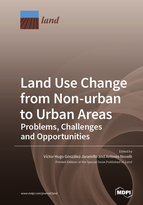Land Use Change from Non-urban to Urban Areas: Problems, Challenges and Opportunities
A special issue of Land (ISSN 2073-445X). This special issue belongs to the section "Urban Contexts and Urban-Rural Interactions".
Deadline for manuscript submissions: closed (25 August 2022) | Viewed by 24791
Special Issue Editors
Interests: geographical information systems; remote sensing; regional development
Special Issues, Collections and Topics in MDPI journals
Interests: mapping; planning; remote sensing; big data
Special Issues, Collections and Topics in MDPI journals
Special Issue Information
Dear Colleagues,
In recent decades, developing countries have experienced a widespread population increase. On one hand, this has resulted in a disorganized urban expansion, problems with fast land-use change and the related threats to natural resources. On the other hand, the increase of the population and the progressive urban expansion have caused the conversion of agricultural areas into urban spaces.
In general, this land-use change between urban and rural produces serious problems, especially related to lack of food supply and increased demand for infrastructure and basic services. These problems are more prominent in poor and developing countries, but they also represent a challenge for developed ones, where wellbeing is also affected.
These issues related to non-urban and urban interactions need to be analyzed in different ways, and they should be considered an opportunity to find practical and sustainable solutions, where academic research must be linked with governments and their regulatory statements to achieve the goal of sustainable development. In this Special Issue, we welcome studies related to land-use change and non-urban and urban relationships at all spatiotemporal scales. This includes:
- Land-use planning schemes to progressive urban expansion;
- Regulatory strategies;
- Planning for a sustainable future;
- Geospatial-based decision support systems (DSS);
- Spatiotemporal dynamics, socioeconomic implication, water supply problems and deforestation land degradation (e.g., increase of imperviousness surfaces) produced by urban expansion and their resource requirements. Studies including the exploitation of low/high-level remote sensing imageries are also welcomed.
Dr. Víctor Hugo González-Jaramillo
Dr. Antonio Novelli
Guest Editors
Manuscript Submission Information
Manuscripts should be submitted online at www.mdpi.com by registering and logging in to this website. Once you are registered, click here to go to the submission form. Manuscripts can be submitted until the deadline. All submissions that pass pre-check are peer-reviewed. Accepted papers will be published continuously in the journal (as soon as accepted) and will be listed together on the special issue website. Research articles, review articles as well as short communications are invited. For planned papers, a title and short abstract (about 100 words) can be sent to the Editorial Office for announcement on this website.
Submitted manuscripts should not have been published previously, nor be under consideration for publication elsewhere (except conference proceedings papers). All manuscripts are thoroughly refereed through a single-blind peer-review process. A guide for authors and other relevant information for submission of manuscripts is available on the Instructions for Authors page. Land is an international peer-reviewed open access monthly journal published by MDPI.
Please visit the Instructions for Authors page before submitting a manuscript. The Article Processing Charge (APC) for publication in this open access journal is 2600 CHF (Swiss Francs). Submitted papers should be well formatted and use good English. Authors may use MDPI's English editing service prior to publication or during author revisions.







